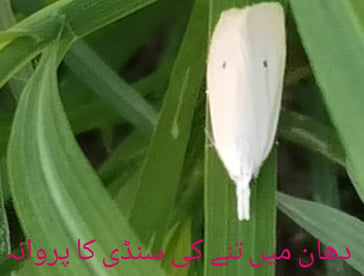Rice Pests Infestations in Punjab, Pakistan
Recent observations in Punjab, Pakistan, have shown that infestations of rice pests have surpassed threshold levels, posing a serious threat to young rice crops. Immediate attention is needed to prevent devastating losses for farmers and the agricultural industry.
SPOTLIGHT
Naveed Shahzad
8/20/2024


Recent observations in Punjab, Pakistan, have shown that infestations of rice pests, particularly the rice leaf folder and rice stem borer, have surpassed threshold levels in young rice crops. If left unchecked, these pests could inflict damage exceeding economic injury levels, posing a serious threat to the crop's viability. The situation demands immediate attention, as the potential losses could be devastating for farmers, the agricultural industry, and the country's export economy.
Causes and Current Challenges:
The recent heavy and frequent rains across Punjab have significantly contributed to the rise in pest pressure on the rice crop. This climatic condition has created an environment conducive to the proliferation of pests, making it difficult to manage infestations effectively. The challenge now lies in the hands of crop protection and extension departments, along with the private sector, to urgently disseminate high-alert messages to the farming community. It's crucial to utilize all available communication channels to ensure that farmers are informed about the correct pesticide applications, including the use of chemical solutions such as Lambda cyhalothrin, Chlorantraniliprole, and Cartap hydrochloride, to effectively control the pests and mitigate the damage.
Importance of Timely Intervention:
The situation is particularly critical in the aftermath of the recent failure of hybrid rice crops and Irri varieties in Sindh and Southern Punjab, which resulted in significantly low yields due to empty panicles. With fine rice varieties now being the last hope for farmers, the industry, and exporters, the need for a bumper crop in the 2024-25 season is paramount. Achieving a record-breaking rice export of $3.88 billion, as seen in 2024, hinges on the success of this crop.
Proposed Solutions:
Immediate Pest Control Measures:
Rapid deployment of chemical solutions like Lambda cyhalothrin, Chlorantraniliprole, and Cartap hydrochloride, under guidance from agricultural experts, to control the infestations before they reach irreversible levels of damage.
Encourage the adoption of Integrated Pest Management (IPM) practices that combine chemical control with biological and cultural methods to sustainably manage pest populations.
Enhanced Communication and Education:
Strengthen communication channels between agricultural departments, private sector entities, and farmers to ensure the swift and accurate dissemination of pest control information. This can be done through SMS alerts, social media platforms, radio broadcasts, and community meetings.
Provide hands-on training sessions for farmers on the proper application of pesticides and the importance of monitoring pest levels regularly.
Monitoring and Early Warning Systems:
Implement an enhanced pest monitoring system that allows for real-time tracking of pest populations and the timely identification of emerging threats. This system could include digital tools and mobile apps that enable farmers to report pest sightings and receive tailored advice.
Support for Affected Regions:
Allocate resources and support to regions that have suffered from the failure of hybrid rice crops and Irri varieties. This could include financial assistance, access to high-quality seeds, and guidance on best practices for cultivating fine rice varieties.
Facilitate the introduction of crop insurance schemes to protect farmers from losses due to pest infestations and adverse weather conditions.
Long-Term Strategies:
Invest in research and development to breed and promote pest-resistant rice varieties that can withstand the climatic challenges of the region.
Encourage the diversification of crops in areas prone to pest outbreaks, reducing the reliance on a single crop and thereby minimizing risk.
Conclusion:
The current pest situation in Punjab's rice fields presents a significant threat not only to the local farming community but also to Pakistan's agricultural industry and its reputation on the global stage. Swift, decisive action is required to safeguard the crop, ensure the livelihood of farmers, and maintain the country's export targets. By implementing the suggested solutions, Pakistan can navigate these challenges and work towards a prosperous and sustainable future for its rice industry.
Please note that the views expressed in this article are of the author and do not necessarily reflect the views or policies of any organization.
Naveed Shahzad is an Entomologist and CEO of Punam Seeds, Faisalabad, Pakistan
Related Stories
Reframe your inbox
Subscribe to our newsletter and never miss a story.
We care about your data in our privacy policy.
"The Agricultural Economist," your essential weekly guide to the latest trends, research, and insights in the world of agriculture and economics.
The Agricultural Economist © 2024
Published by The AgEcon Frontiers (TAEF)
All rights of 'The Agricultural Economist' are reserved with TAEF
